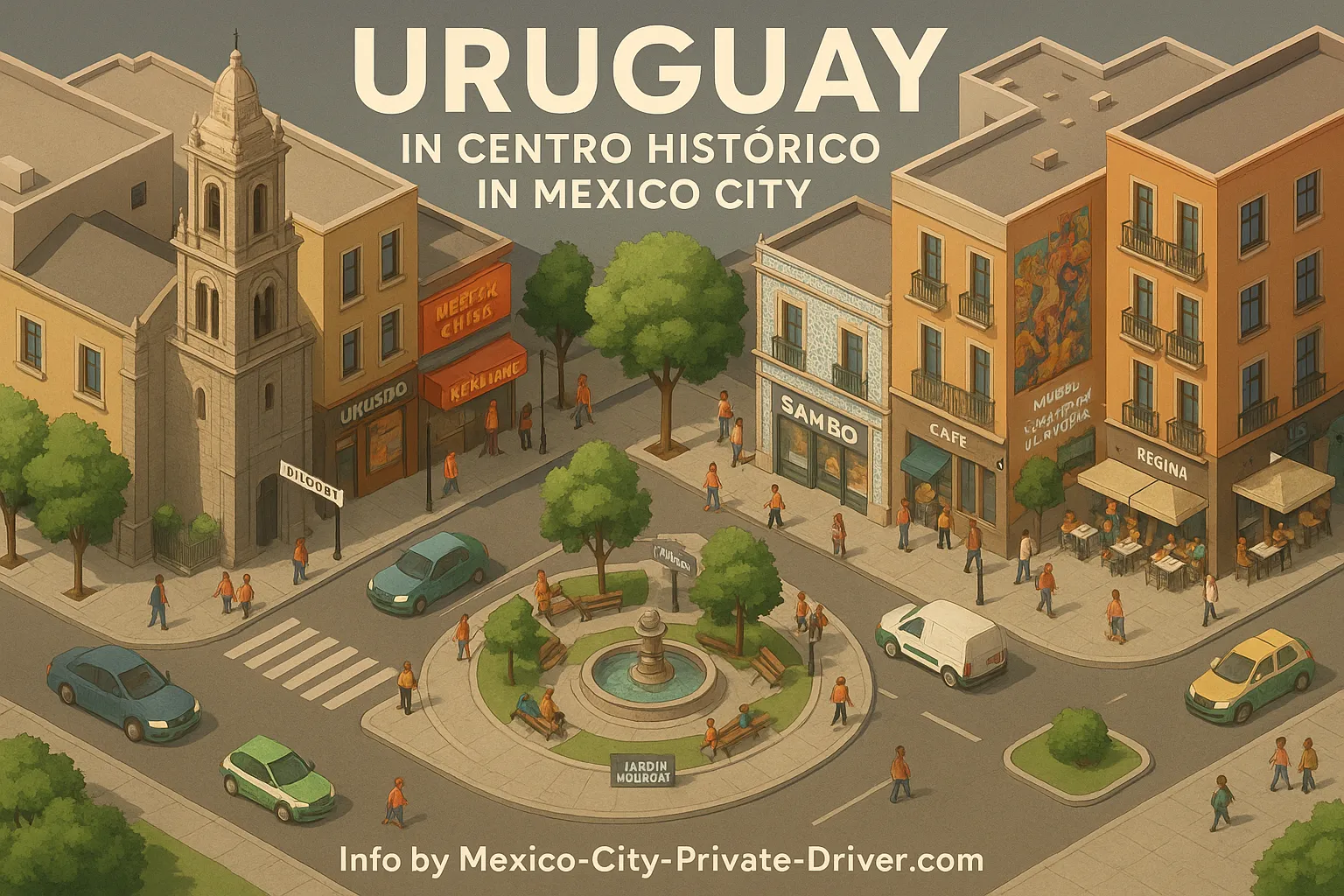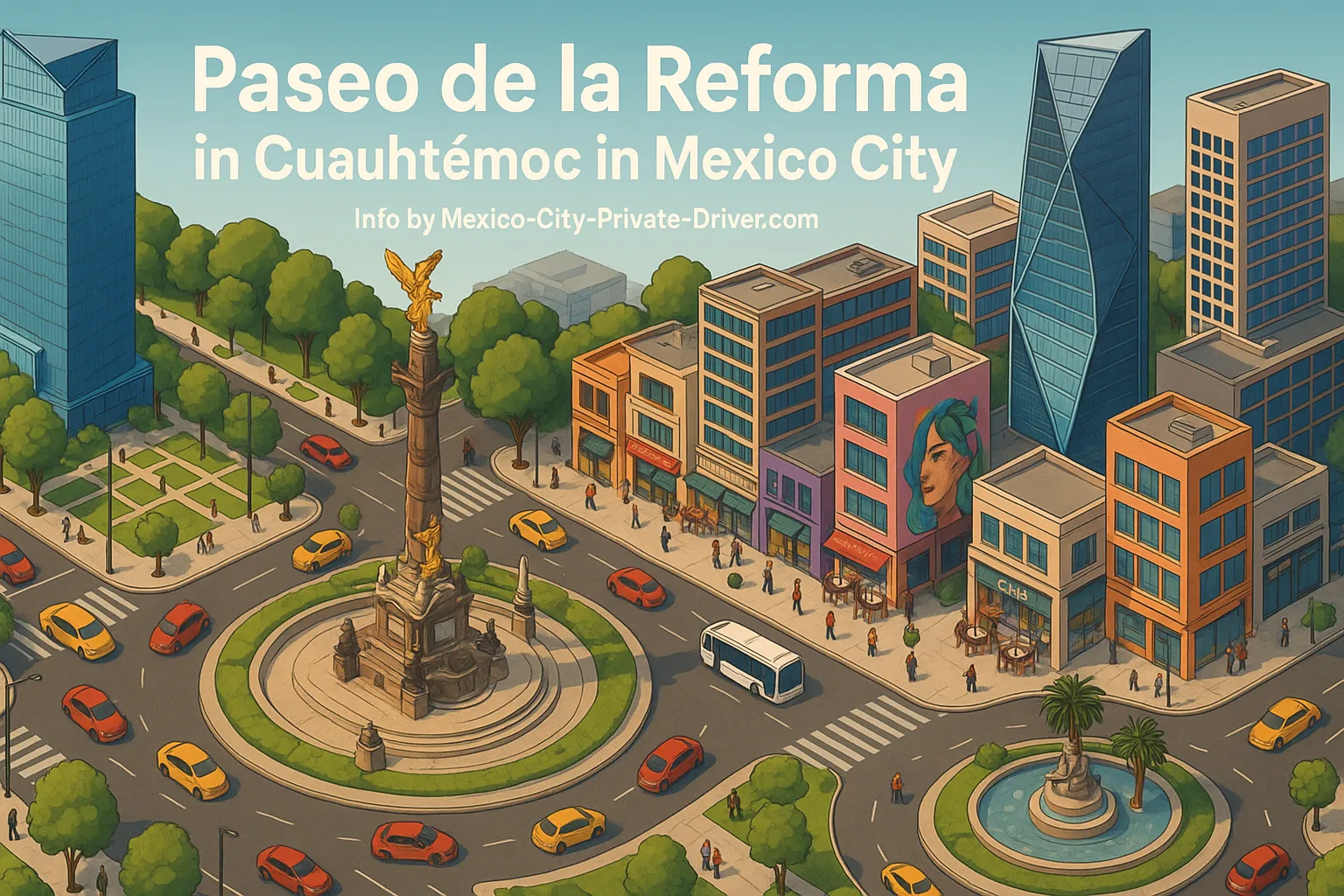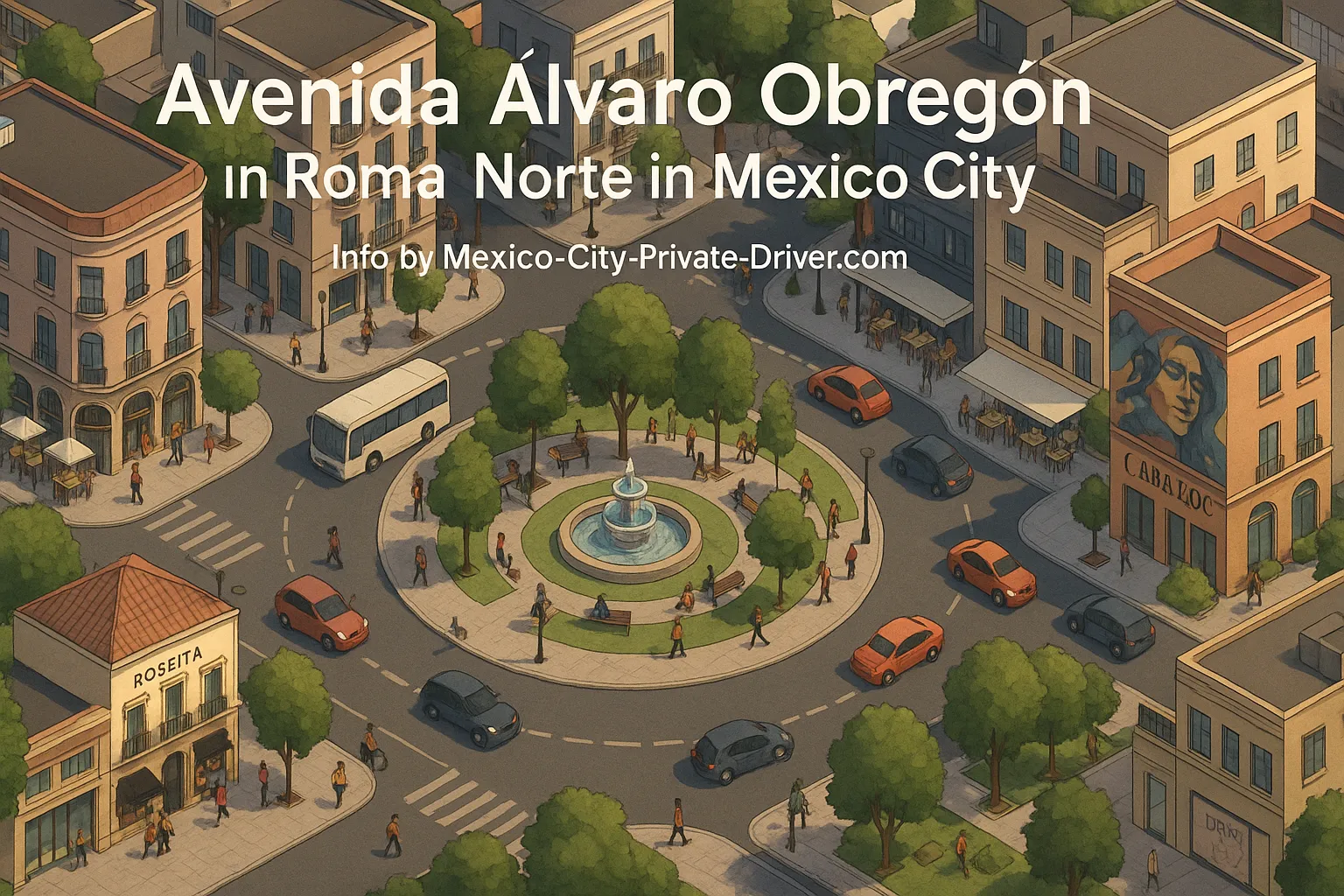Finding Calle Uruguay in the Centro Histórico — a private driver’s perspective
As the owner and lead driver at Mexico-City-Private-Driver.com, I spend more hours behind the wheel in downtown Mexico City than I do in my own kitchen. One of those little streets that keeps drawing me—and my clients—back is Calle Uruguay in the Centro Histórico. It’s not a boulevard or a headline-grabbing avenue; it’s a short, character-filled street tucked among the grand plazas, colonial façades, and the pulse of Mexico City’s old civic center. But for guests who want to experience authentic Centro life with the convenience and safety a private driver provides, Calle Uruguay makes for a perfect stop or a flexible pickup point.
Quick orientation: where Calle Uruguay sits in Centro Histórico
Calle Uruguay sits in the heart of the Centro Histórico, within the dense web of colonial-era streets and blocks that surround the Zócalo, Palacio de Bellas Artes, and Torre Latinoamericana. From the kind of vantage point I work with every day:
- Walking distance to major landmarks: Calle Uruguay is a short walk from Bellas Artes, Alameda Central, the Zócalo, and the historic axis that takes you past the Catedral Metropolitana and Templo Mayor.
- Close to major hotel pickup points: Gran Hotel Ciudad de México, Hotel Zócalo Central, and several boutique properties in the area are within a few minutes by foot or a short drive through Centro’s restricted streets.
- Connected to the main transit spine: The street is easily reachable from the main Centro metro stations and the avenues where Metrobús and taxis circulate—though, as I’ll explain, I rarely recommend clients rely on street parking or curbside pickups here.
Why Calle Uruguay matters for travelers
People ask me: “Why would I want to stop on such a small street?” My answer is always practical and personal. Centro Histórico is best experienced slowly. A short detour to Calle Uruguay allows clients to see living, working Mexico City—street vendors, small cafés, anachronistic hardware stores, a hidden courtyard, or a shuttered colonial doorway—without getting swallowed by the crowds at the Zócalo. As a private driver, I can pick a drop-off spot close to your door, wait a short while, and then move on—something hotel taxis and ride-hailing apps can’t always manage efficiently in this neighborhood.
Street layout and driving reality
Centro Histórico streets are a patchwork of narrow colonial alleys, one-way streets, and larger avenues. Calle Uruguay follows that pattern:
- Narrow but navigable: Calle Uruguay is pedestrian-oriented and relatively narrow. Larger vehicles can pass in a single lane but space is tight when vendors and pedestrians are present.
- Typically one-way: Many streets in Centro are one-way; I plan my route around these restrictions, using larger arteries for access and choosing simpler pick-up points when needed.
- Limited parking and loading zones: Short-term curbside stopping (for pickups and drop-offs) is possible in early morning hours or when traffic is light, but long-term parking is not practical. There are municipal or private lots within a short walk.
My practical rule: I avoid parking on Calle Uruguay for long periods. Instead, I use a nearby wider avenue (for example, a frontage on Avenida 5 de Mayo, Eje Central, or the plazas flanking the Zócalo) as a staging area. If a client needs me to wait, I’ll position the vehicle where it won’t obstruct deliveries, emergency access, or procession routes.
Traffic conditions and rush hours
Centro Histórico traffic follows predictable patterns:
- Mornings (07:00–10:00): Busy with commuters, deliveries, and people running errands. Narrow streets like Uruguay fill with local traffic, bicycles, and supply trucks—I avoid making stops then unless absolutely necessary.
- Midday (11:00–15:00): Peak tourism hours. Pedestrian flow increases sharply around Bellas Artes and the Zócalo; vehicle movement slows to a crawl on major streets.
- Evening (18:00–22:00): Restaurants and cantinas draw crowds; streets are lively and parking is scarce. Nighttime is great for clients but requires a secure, pre-arranged pickup location.
Driving and parking details visitors should know
As someone who ferries guests through Centro daily, I’ve learned to translate local rules into useful steps for visitors:
- Staging spots: I typically ask hotels to allow me to stage on their curb when possible, or I use one of the bigger arteries adjacent to the Centro (Paseo de la Reforma, 5 de Mayo, or Eje Central). This keeps the pickup predictable and avoids sudden honking and fuss.
- Private parking lots: There are paid parking lots and valet services in Centro—the Gran Hotel and several museum-adjacent buildings run secure lots. If you’re staying in a hotel, always ask if they offer a safe valet or guest parking.
- Ticketing and enforcement: Mexico City enforces parking regulations; I won’t risk a client’s schedule for street parking. If we need to park, I’ll find a garage and walk you the last stretch when possible.
Local regulations and restricted zones
Certain blocks in Centro are subject to municipal restrictions at times—processions, official ceremonies at the Zócalo, cultural events at Bellas Artes, and weekend pedestrianizations can alter traffic flow. A few points:
- Event closures: The Zócalo and surrounding streets can be closed for events with short notice. I monitor local event calendars and coordinate pickups accordingly.
- Pedestrian-only lanes: Some streets are pedestrianized on weekends or for special events. Calle Uruguay can be unusually crowded during such times; a private driver helps you avoid the hassle of dropped luggage and last-minute reroutes.
- Security checks: Police or municipal checkpoints are not uncommon around government buildings and large public events. Driver ID and vehicle credentials are standard; as a licensed private driver, I handle these interactions smoothly.
Public transportation access near Calle Uruguay
If you prefer to combine a private driver with public transport, the Centro is extremely well-connected. From my vantage:
- Metro: Several Centro stations are a short walk away. The Zócalo and Bellas Artes stations place you within a 5–12 minute walk of Calle Uruguay. (I’ll usually pick you up at a clear street-level landmark to avoid confusion.)
- Metrobús and surface transit: Major avenues that border Centro—such as Paseo de la Reforma and Eje Central—carry Metrobús routes and plenty of regular buses. I often meet clients who prefer to save on fares and then take the car for a larger day trip.
- Taxis and ride-hailing: Readily available, but not always efficient for groups, luggage, or precise timed pickups. I find our private service offers more predictability for scheduling museum visits, restaurant reservations, or airport transfers.
Why hire a private driver for Calle Uruguay and Centro Histórico?
Here’s the honest, professional take: Centro Histórico is marvelous to experience on foot, but getting there, moving around, and leaving on time is an art. With a private driver you get:
- Flexible timing: Spend 20 minutes or three hours—your schedule is the priority.
- Safe and efficient luggage handling: I handle bags, set down quickly near entrances, and coordinate final pickups with the concierge.
- Insider route planning: I know which streets close for markets, which blocks get clogged by deliveries, and when to stage on a main avenue to avoid the drivers’ gridlock.
- Local context: As we move through the Centro, I’ll tell you stories about the buildings, point out the best cafés, and highlight small workshops you might miss otherwise.
Local tip: Best time to see Calle Uruguay without the crowds
If you want photos and calm streets, aim for early morning—between 08:00 and 09:30 on weekdays. Vendors are setting up, municipal cleaning crews are working, and the light on the colonial façades is beautiful. I often schedule a 30–45 minute walk then, followed by a coffee at a nearby café not yet overrun by tourists.
Where to meet and how I manage pickups
My experience taught me three practical pickup strategies for narrow Centro streets like Calle Uruguay:
- Hotel curbside pickup: I always ask hotels to allow me to stage briefly at the curb. Hotels like Gran Hotel, Hotel Zócalo Central, and the NH Collection (central properties) are used to professional drivers and usually cooperate.
- Designated plaza or avenue staging: For groups or luggage-heavy pickups I use a wider avenue or plaza nearby (e.g., Alameda Central or Avenida 5 de Mayo). I text the client the precise landmark and keep the car warmed up.
- Meet at a café or museum entrance: For walking tours through the Centro, meeting at a museum entrance (Bellas Artes is perfect) gives us a common reference point and a comfortable waiting area if you arrive early.
Pro tip: With narrow streets, I’ll often request a 5–10 minute grace period from the client—this prevents the stress of jockeying for position when traffic is heavy or when a procession blocks the way.
Nearby attractions and custom routes I build around Calle Uruguay
One reason I love routing clients through Calle Uruguay is the number of high-value stops you can stitch into a single, efficient loop. Here are a few of my favorite custom routes I run regularly:
Short cultural loop (2–3 hours)
- Start: Pickup at your Centro hotel or Bellas Artes
- Stop 1: Palacio de Bellas Artes — quick photos and a façade tour
- Stop 2: Walk to Calle Uruguay — 20–30 minute street-level stroll to see a working neighborhood
- Stop 3: Coffee at a nearby traditional café or a boutique café in a restored courtyard
- Finish: Quick view from Torre Latinoamericana (optional elevator up for a panoramic view)
Historical deep-dive (half-day)
- Start: Hotel pickup (Condesa, Roma, or Polanco—easy drive into Centro)
- Stop 1: Zócalo — cathedral exterior, Templo Mayor
- Stop 2: Mercado de Artesanías or a specialty workshop near Calle Uruguay (time for a brief artisan visit)
- Stop 3: Lunch at a traditional eatery recommended by me—I’ll pick a place with good service and real local flavors
- Stop 4: Small museums or galleries near Calle Uruguay, ending at Bellas Artes or Alameda Central
Neighborhood contrast tour (full day)
- Start: Pickup in Polanco (e.g., from a hotel near Presidente Masaryk)
- Stop 1: Quick drive through Condesa to show Avenida Ámsterdam and tree-lined streets (a very different vibe than Centro)
- Stop 2: Roma Norte — café break at a trendy spot
- Stop 3: Drop into Centro, walk Calle Uruguay to feel the colonial context
- Stop 4: Museum visits and lunch, ending with a return to Polanco
Note how I use Avenida Ámsterdam (Avenida Ámsterdam, Amsterdam Avenue, Amsterdam Street) as a contrast to Centro’s Calle Uruguay—this juxtaposition highlights the variety of Mexico City neighborhoods and the efficiency of having a private driver who understands both ends of the city.
Local safety and security insights only a driver will likely tell you
Centro Histórico is safe to visit by day and has a lively night scene, but there are practical safety considerations:
- Pick your entry point: Some streets have poorer lighting at night. I always choose well-lit streets and avoid leaving clients in alleys after dark.
- Beware of quick-change vendors: In busy tourist areas, opportunistic pickpocketing and money exchange scams happen. I keep an eye on the crowd flow during stops.
- Watch for official-looking uniforms: Not all uniforms are official. If someone asks you for payment or a fine in the street, ask me first—I’ll verify before you hand over money.
Benefits for visitors when using my private driver services around Calle Uruguay
Why choose my service for a stop at Calle Uruguay?
- Time management: You won’t waste time searching for parking or waiting for a ride—your itinerary runs on your clock.
- Customized experiences: Want to pop into a restoration workshop, meet a collector, or pick up a special mezcal from a family-run store? I can set that up quickly because I know the owners and the rhythms of the street.
- Comfort and accessibility: If you have mobility needs or elderly travelers, I’ll arrange the closest possible drop-off, avoid steep steps, and bring cushions and shade when needed.
Hotel and pickup references I use every day
When routing clients to or from Calle Uruguay, these hotels and points make the logistics easy:
- Gran Hotel Ciudad de México — ideal staging and a short walk to Zócalo
- Hotel Zócalo Central — good curb access and helpful concierge
- NH Collection (Centro Histórico locations) — professional valet services and easy in/out
- Boutique hotels on República de Guatemala and nearby streets — often have small, cooperative valets
The “wow” story: a surprising courtyard on Calle Uruguay
I want to share one of those little moments that make this work meaningful. One drizzly afternoon I picked up a client who was an American art restorer. We had a block of time between museum appointments, so I suggested a short detour down Calle Uruguay—honestly more for atmosphere than expectation.
We passed a weathered wooden door with a tiny, almost invisible brass plate. I’d passed it a hundred times and never seen it open. Today, someone was propping it ajar and an elderly woman at the threshold waved us in. It turned out to be a family-run workshop that had been restoring colonial tiles and painted frames since the 1940s. The owner—an obliging man with paint-stained hands and a soft voice—gestured us into a sunlight courtyard where walls were lined with hand-glazed tiles and faded political posters.
My client, the restorer, knelt down and began to examine a crumbling tile. Time melted away. Two hours later we left with a pocketful of stories, a tiny commissioned tile, and an invitation for a return visit. I still remember my client’s whisper: “This is why I came.”
That little courtyard is the essence of what Calle Uruguay offers: a chance encounter, a tangible connection to Mexico City’s continuity of craft, and the kind of serendipity you only get when someone trusted is at the wheel and has the local relationships to make a door swing open.
Insider tips only a private driver would tell you
- Pack small bills: Vendors and small cafés around Calle Uruguay often don’t accept cards or big notes. I always carry small bills for clients for quick purchases.
- Plan for toilets: Public restrooms are rare here—use the museum or café toilets when you can. I’ll proactively plan stops at places with facilities.
- Timing for food: Lunch in Centro is usually between 13:00 and 15:00. If you want to avoid the rush, ask me to schedule an early or late lunch; I’ll pick a place where service is reliable and authentic.
- Language and negotiation: I’ll handle any local negotiation or purchases. I speak Spanish and many of the shopkeepers know me. That removes awkward bargaining from your agenda.
- Cashless fallback: If you prefer to be cashless, tell me in advance—I’ll pre-pay certain experiences and collect a single payment for the day when it’s convenient.
Comparing Calle Uruguay with Avenida Ámsterdam (Condensa) and other neighborhoods
To help travelers understand neighborhood contrasts, I often explain Centro by comparison:
- Calle Uruguay / Centro Histórico: Dense, historic, intensely urban—great for history, architecture, and street-level life.
- Avenida Ámsterdam (Condensa) / Amsterdam Avenue: Tree-lined, laid-back, with a European feel—perfect for relaxed cafes, boutiques, and a slower pace.
- Roma / Roma Norte: Trendy, artsy, café-heavy—ideal for contemporary dining and galleries.
- Polanco: Upscale, shopping-heavy, with world-class restaurants—good for luxury itineraries and polished experiences.
When clients want a curated taste of the city in one day, I’ll take them from the leafy Ámsterdam Avenue in Condesa to the creative bustle of Roma Norte and finish at Calle Uruguay in Centro Histórico for a rich, historical evening meal. It’s a perfect microcosm of CDMX’s diversity.
How I price and structure a visit that includes Calle Uruguay
My pricing is transparent and designed for flexible, guided experiences. Typical structures include:
- Hourly tours: Ideal for short loops in Centro—pickups, drop-offs, and a 2–3 hour walking stop on Calle Uruguay.
- Half-day and full-day: For deeper exploration across neighborhoods (Polanco, Condesa, Roma, and Centro), including multiple stopovers and lunch coordination.
- Custom itineraries: For clients with particular interests (art restoration visits, family history, shopping for crafts), I build a route and prearrange contacts.
If you plan to include Calle Uruguay in your day, I recommend at least a half-day so we can move at an unhurried pace—there’s a surprising amount to discover in an hour if you know where to look, and even more if you have the time to linger.
Final thoughts and how to book
Calle Uruguay in the Centro Histórico is small but emblematic: it’s part of the living fabric of Mexico City, where everyday life, artisanship
Martin Weidemann is a digital transformation expert and entrepreneur with over 20 years of experience leading fintech and innovation projects. As a LinkedIn Top Voice in Digital Transformation and contributor to outlets like Forbes, he now brings that same expertise to travel and mobility in Mexico City through Mexico-City-Private-Driver.com. His focus: trustworthy service, local insights, and peace of mind for travelers.



